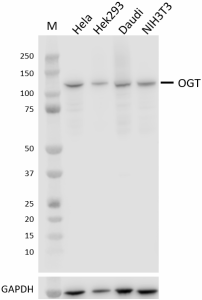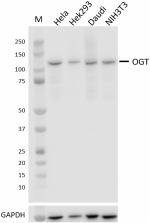- Clone
- W20094A (See other available formats)
- Regulatory Status
- RUO
- Other Names
- O-linked N-acetylglucosaminyltransferase (O-GlcNAc transferase, OGT) subunit p110, UDP-N-acetylglocuosamine--peptide N-acetylglucosaminyltransferase 110 kDa subunit
- Isotype
- Rat IgG2b, κ
- Ave. Rating
- Submit a Review
- Product Citations
- publications

-

Whole cell extracts (15 µg protein) from the indicated cell lines were resolved on a 4-12% Bis-Tris gel, transferred to a PVDF membrane, and probed with 1 µg/mL of purified anti-OGT (clone W20094A) overnight at 4°C. Proteins were visualized by chemiluminescence detection using HRP goat anti-rat IgG (Cat. No. 405405) at a 1:3000 dilution. Direct-Blot™ HRP anti-GAPDH (Cat. No. 607903) was used as a loading control at a 1:50000 dilution. Western-Ready™ ECL Substrate Plus Kit (Cat. No. 426317) was used as a detection agent Lane M: Molecular weight marker.
| Cat # | Size | Price | Quantity Check Availability | Save | ||
|---|---|---|---|---|---|---|
| 603551 | 25 µg | 95€ | ||||
| 603552 | 100 µg | 235€ | ||||
UDP-N-acetylglucosamine--peptide N-acetylglucosaminyltransferase 110 kDa subunit (OGT) catalyzes the transfer of N-acetyl glucosamine (GlcNAc) post-translational modification to serine, threonine, and cysteine residues of proteins. Serine and threonine residues are modified by O-glycosidic linkage, while cysteine is modified by S-glycosidic linkage. Since the amino acids utilized for O-GlcNAcylation are identical to those used for protein phosphorylation, OGT competes with kinases for modification of those sites. Numerous functions for GlcNAcylation have been reported in regulating protein-protein interactions, and OGT plays diverse roles in the regulation of the cell cycle, transcription, and cellular stress. Dysregulation of O-GlcNAcylation plays a role in the pathology of Alzheimer’s disease, cancer and diabetes. OGT activity is regulated by glucose availability, and plays a role in regulating glycolysis by glycosylation of phosphofructokinase.
Product DetailsProduct Details
- Verified Reactivity
- Human, Mouse
- Antibody Type
- Monoclonal
- Host Species
- Rat
- Immunogen
- Recombinant human OGT protein fragments
- Formulation
- Phosphate-buffered solution, pH 7.2, containing 0.09% sodium azide
- Preparation
- The antibody was purified by affinity chromatography.
- Concentration
- 0.5 mg/mL
- Storage & Handling
- The antibody solution should be stored undiluted between 2°C and 8°C.
- Application
-
WB - Quality tested
- Recommended Usage
-
Each lot of this antibody is quality control tested by western blotting. For western blotting, the suggested use of this reagent is 0.25 - 1 µg/mL. It is recommended that the reagent be titrated for optimal performance for each application.
- Application Notes
-
This product does not meet passing criteria for ICC and IHC.
- RRID
-
AB_2922635 (BioLegend Cat. No. 603551)
AB_2922635 (BioLegend Cat. No. 603552)
Antigen Details
- Structure
- OGT is a 1,046 amino acid protein with a predicted molecular mass of 116.9 kD.
- Distribution
-
OGT is expressed in the cytoplasm of most cells.
- Function
- OGT is an enzyme which catalyzes the attachment of the O-GlcNAc post-translational modification.
- Interaction
- OGT glycoylates a wide array of proteins including histone H2B, AKT1, and EZH2.
- Biology Area
- Cell Cycle/DNA Replication, Cell Proliferation and Viability, Protein Synthesis
- Molecular Family
- Enzymes and Regulators, Protein Modifiers
- Antigen References
-
- Canovas B and Nebreda A. 2021. Nat Rev Mol Cell Biol. 22:346-366.
- Gene ID
- 8473 View all products for this Gene ID
- UniProt
- View information about OGT on UniProt.org
Related Pages & Pathways
Pages
Other Formats
View All OGT Reagents Request Custom Conjugation| Description | Clone | Applications |
|---|---|---|
| Purified anti-OGT | W20094A | WB |
Compare Data Across All Formats
This data display is provided for general comparisons between formats.
Your actual data may vary due to variations in samples, target cells, instruments and their settings, staining conditions, and other factors.
If you need assistance with selecting the best format contact our expert technical support team.
-
Purified anti-OGT

Whole cell extracts (15 µg protein) from the indicated cell ...
 Login / Register
Login / Register 







Follow Us